Special Thanks to Caseys42/jjj for Making the Picture and Allowing Me to Upload It~
Information technology seems like and then long ago when I first stepped into the MakerLab that January evening. I call up that the first time, I had trouble finding the room in BIF, just information technology soon became a form that I always looked forrad to on Monday afternoons. Sad to come across it all go, simply I've learned and experienced so much in my time here that it was well worth the time spent. After signing upwards for the course, I initially believed it would be exclusively about 3D printing, and a expert way to go on up with my hobby. And while the course was indeed mainly centered on additive manufacturing, we explored many other related aspects. I got to feel other non-conventional uses of 3D printing, other making processes such every bit laser cutting, and get more intuitive with the art of the creative procedure in full general. It'south been a fantastic semester, and I'm happy to recap it all hither.
Intro to 3D Printing:
I've already a lot of feel with 3D printers ever since high schoolhouse, which is the chief reason that I took upward this course. It had been a while since I had used one, just when nosotros began to go over the basics of 3D printing everything started to catamenia dorsum in. I was really excited to work with the Ultimakers every bit they were the highest quality printers that I take always worked with bated from peradventure Makerbots. For my get-go print in the lab, I printed a simple whistle.
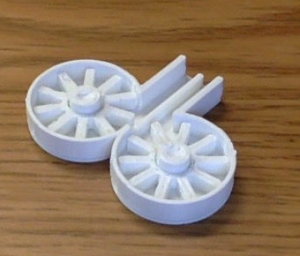
Pattern Thinking:
I used multiple CAD programs for a variety of projects ever since I got into 3D press. And before I took the Digital Making form I believed that all their was to it was creating a model in CAD and printing it. If information technology didn't work, just try again. On the very surface, it actually is that simple; but if you dig deeper there is much more backside information technology. Every idea; every blueprint; every creation is born out of necessity. They each have their ain purpose decided by the user. I used to believe that everything I did in my artistic procedure just came out of thin air, but in reality I was following a similar design. Design thinking is the basis of all trouble-solving.
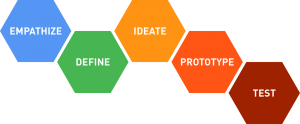
Fusion 360:
Fusion was the most complex software I had ever dealt with, and I am very glad I was introduced to information technology in the grade. For the nearly function, all my designs were created with simpler softwares such as TinkerCAD and 123D design. Fusion 360 was quite the step upward. It'southward a complex yet vivid software the contains a plethora of tools and allows the user to operate and edit their model with much greater freedom than most other CAD programs. While difficult to get used to, in the proper hands it can create anything.
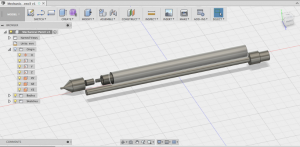
The Fab Lab:
Our adventures at the CU community Fab Lab might just exist my favorite part of the form. I was amazed that such a wonderful and innovative identify was practically hidden on campus. Unless you had prior cognition you'd probably never realize it was here. It was satisfying to know that at that place was a place on campus where makers could get to explore and innovate. It's a place where ides flourish and become reality. Those iii weeks we spent there, learning the different making processes (Programming, Electronics, and Laser Cutting) and being able to create our own special projects was incredibly fun and very memorable. I'1000 sure to call up the Fab Lab for the residual of my fourth dimension here at UIUC and if I e'er need anything for a special endeavor, I know where to expect.
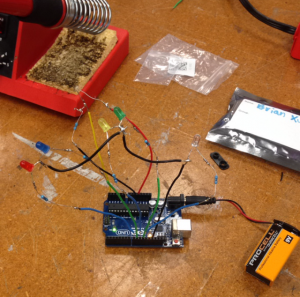
Laser Cut
Arduino IDE
The result of all three

Art Addendum 2
1301 S Goodwin Artery
Urbana, IL 61801
3D Scanning:
Beingness able to scan a 3D model of one's ain bust for printing is virtually as erstwhile every bit 3D press itself. While I didn't actually partake in information technology, information technology was a skillful experience to actually run into it first hand. It's a shame we couldn't contain something like it into our project, or that the desktop 3D scanner didn't seem to work well. But they are both still quite fascinating and agreeable.
Scanning
Takeaways:
Taking this course was really a please for me. I became very passionate about 3D printing a few years ago, and was overjoyed when I plant out in that location was a grade available involving it. I got to explore my hobby again, and discuss it with other individuals who were too interested. I was able to improve upon my existing skills, as well as gain some new ones. To wrap it all up, I got the opportunity to use what I've gained and know to create one big final projection to share with the rest of the class. Beingness able to encounter what anybody else had created and sharing our ideas was a pleasure. It'southward been a fun semester, and I'm glad I was able to experience this my freshman year, which means I'll take plenty of time to be in the MakerLab. I'd similar to extend my thanks to Vishal for education the grade, the MakerLab gurus for existence so helpful, all the guest speakers, the folks at the Fab Lab, and my fellow makers who ventured this course with me. It'south been a boom!
This calendar week, we continued our piece of work with our final projects. Yet, we added something a footling dissimilar this time, in that each grouping was assigned to inspect another grouping'southward design. This was dissimilar from our usual group sharing in that we actually had the hazard to sit down and really delve deeper into another group's work and vice-versa. This allowed each group to properly and efficiently critique some other pattern, every bit well as receive feedback of their ain.
Our group was outset paired with JJJ Inc., who are currently developing the smart lightswitch; a smartphone-operated device that uses an awarding to command a motor to operate a lightswitch from a distance. While information technology may seem relatively elementary, the corporeality of attempt and creativity they have put into it is phenomenal. They designed their ain laser-cut casing and have incorporated an Arduino into their project, making full use of the skills they gathered during our fourth dimension at the Fab Lab. Their project is based off efficiency and aesthetics. Being able to turn the lights on or off from a distance with only a smart-device is something many people would admire, and adamantly use. And the enclosure they've created for their device looks groovy, as well. It appears to operate perfectly and serves its purpose. Quite a unique and expertly done take on a archetype dilemma. One "upshot", so to speak, that we did foresee however is that it is somewhat bulky and maybe arduous to install and/or remove. Likewise, their blueprint, as information technology stands, merely works for traditional light switches. Dimmer/rotary switches can't really exist turned past the motor. Even so, that could definitely exist something they could create/improve if they ever choose to have the product to market. Perhaps by making two different designs or adding some features to their existing i.
We besides received some much-appreciated feedback for our design. JJJ Inc. recommended that we add some physical grooves to the tie helper not simply to arrive more than flexible, simply every bit a method to brand information technology easier for the user to determine where each terminate of the tie may go. They likewise recommended that we perhaps look into resizing the design and possibly changing the thickness. All practiced suggestions, just we recently but printed an edited version of our paradigm in semi-flex filament, which should mitigate almost if not all of our issues. Later testing this prototype, we should just need to make a few more adjustments to the design to ease apply, but the overall construction and plan of the project is complete. It's been an exciting semester; we take all gained some very enhanced skills that allowed us to create these projects. I'chiliad looking forward to seeing what nosotros all accept produced.
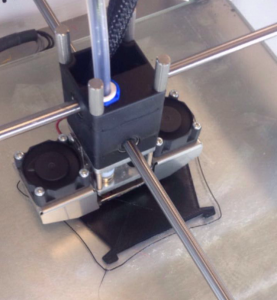
This calendar week, we headed dorsum to the MakerLab to proceed working on our terminal projects. Beforehand, though, we given a sit-in of another technique for creating 3D objects and as well could perchance be incorporated into our terminal projects: 3D scanning. By utilizing a digital scanner, one can browse any object or fifty-fifty their own bust for modeling and printing. I can see how this method could exist used in some of the form projects, merely my group volition most probable not demand information technology. So later the demonstration and some toying effectually with it, we got back to piece of work.
3D scanning is based on using specially designed scanners to browse every inch of an object, which computer software then pieces together to create a 3D model. The two types of scanners we were introduced to were desktop and mobile scanners. The desktop scanner was equanimous of a special light amplification by stimulated emission of radiation device with a rotating plate that would let for a 360 degree view of an object. The mobile version was a smaller and more than compact device that fastened to an iPad photographic camera. The iPad version seemed to be more reliable equally a person could freely move around the object or person they were scanning to get an accurate impression. The desktop scanner does work, but can be pretty ineffective at times. It is hands skewed by darker objects, or those with "hidden" features that tin can't easily be detected, such as if one portion of the object blocks another. Shadows are also an issue too, so its recommended that the objects scanned be completely white is possible. Later the objects are scanned, they are imported as a model into software where a user can edit the model for errors or only make adjustments if desired. When done under adept circumstances, the results tin be quite phenomenal. They may not be perfect, just the 3D printed busts created by these scans are very recognizable. 3D scanning for consumer utilise still needs some development, but the current land of it certainly shows its potential.
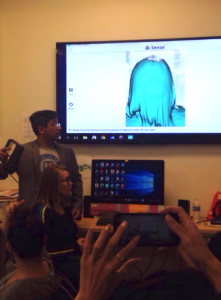

The process on everyone's final projects seems to be going well, everyone is either in the procedure of prototyping or are making adjustments based on their last development. We created our offset model and attempted to churn out a impress for testing, but the extruder unfortunately malfunctioned most half way through. Not all was lost, however, as the basic shape and size of the print are we really wanted to test. Some adjustments definitely demand to be made, but that was to exist expected. Things may not be necessarily going as smoothly every bit hoped for, simply the direction and goal of the project is definitely clear. We've got plenty of work to exercise in terms of processing and testing, but the terminal result volition surely exist worth it.
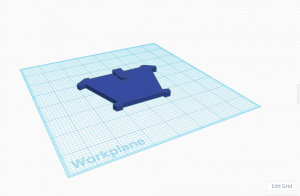
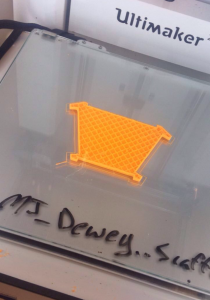
One of the all-time features of consumer 3D printers is their ease of apply. All the user needs is to slice their model with their desired settings and upload information technology to the printer via a USB cablevision, flash drive, etc. While this is straightforward, there are quite a few intricacies to the process. Slicing a 3D model with "perfect" settings does not necessarily atomic number 82 to a perfect impress. There are a plethora of discerning factors and principles of condiment manufacturing that can skew the results. These bug are usually grouped into 3 categories: cloth bug, software, and hardware. User fault can sometimes come into play, but that also usually falls into one of these iii mentioned. 3D press as it is now is not a perfect science, there are many issues prevalent within the applied science that prevent it from existence greater than what it already is. The slightest mishap during or even before a print begins tin can crusade it to fail or lower in quality. Sometimes, prints even neglect for seemingly no reason, and the failed print is merely a erstwhile occurrence. We can, however, take measures to ensure that nosotros tin go the best quality out of our machines equally possible. As 3D printing is however rapidly evolving, at that place really is no "perfect" print. We tin get very loftier quality parts created, but as information technology stands now there is always something that can be improved in a print. This post is meant to serve as a universal guideline/checklist for getting the best quality prints out of your 3D printer as possible.
1. Filament:
In that location are a diversity of press materials out there, with the 2 most pop beingness ABS and PLA. Other types are special exceptions but they ordinarily have the same conditions for printing every bit one of these two. You should choose what type of filament to apply based on what your role requires. Each has its trade-offs.
ABS- Relatively strong with a trivial bit of flex. Adept for parts that volition be used a lot, or pieces that you don't necessarily care how they look. However, information technology is Non food-safe, and somewhat difficult to print. It requires a heated printed, and sometimes a trivial bit of glue on the surface to help with adhesion. It also has a very strong olfactory property so you need a well-ventilated area.
PLA- Probably the nearly common textile used today. It is vegetable-based and is easier to print than ABS. Information technology also tends to look nicer and the prints are more clean coming out. However, information technology is much more than fragile and sensitive to temperature. Therefore, this is skillful for models that won't exist used heavily and are more for display.
More in-depth info on filaments hither: https://pinshape.com/blog/pop-3d-printing-filaments-3d-printer-filament-types/
2. Software
When slicing your file in your slicer, you lot have a diversity of options. Different combinations produces different results, nonetheless, these tin vary widely depending on the software and the printer, besides equally the filament. An important consideration earlier printing is what kind of software you lot are using and if it works properly with your printer. Some companies produce their own proprietary software that can only be used with their printers and vie-verse. This makes it easier for users, just in most situations this really limits the options. They are many other non-locked slicing softwares that tin be used with whatever printer, but not all printers tin can apply whatsoever software. Sometimes you will simply have to examination these for yourself and run into what is compatible with your printer. These are the more common options adjusted by users.
Layer Meridian- How alpine the layers of the filament are in the z-centrality(upwardly management). Usually ranges from .ane mm to .4 mm. The effectively the layers, the higher quality the print will be.
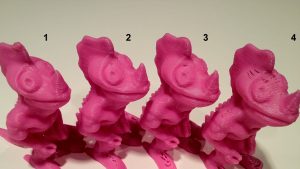
Infill- How dense the object printed volition be, ranging from completely hollow(0 %) to completely solid (100%). Annotation that as yous go higher and higher in percentages, the difference starts to get less noticeable. The shape of the infill is ordinarily also adjustable, these include hexagonal, rectilinear, or fifty-fifty custom settings.
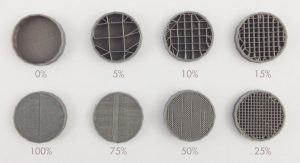
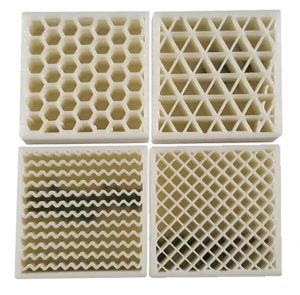
Shells/Perimeter- The number of outer lines the printer will produce on the perimeter of the print. The standard is two. This affects the force of the print.
Speed- How fast the print nozzle will movement during the press procedure. Higher speeds give faster prints, but lower quality, while the reverse is for lower speeds.
Supports- If your impress has overhangs, depending on the angle, the printer may endeavour to build the layers over aught, causing a drooping effect. To recoup, supports (layers thinner than usual), are created by the printer which can exist broken off or in some cases dissolved later. The density of the supports can usually be adjusted as well. Flimsy supports interruption abroad hands, but may also be torn away accidentally by the extruder during printing, while more rigid supports are can hold more reliably but are harder to remove.
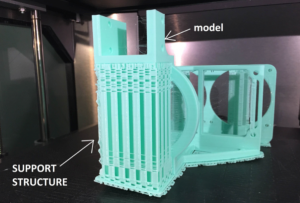
Raft/Brim/Brim- The more surface contact that your impress has, the improve it will attach to the printed during printing. If it has lilliputian surface surface area, there is a possibility that it will actually pare off the printer. In these cases you may want to utilize a raft, brim, or brim. There are all similar just each has a specific utilize. The raft is the nigh generic and is like back up structure just is only composed of a few layers that the model is printed on top of. It is used to provide a larger "footprint" for the model and is removed similar support material. Take note however, that the bottom of the impress is usually affected by this, equally it will tend to be more rough having been printed on tiptop of more than textile rather than the impress bed. A skirt is like and outline of the impress made around it. This is to ensure that the filament is flowing properly before the bodily impress begins. A brim is like a raft, except the bottom layer is printed with the brim instead of on top of it. Information technology provides stability to prints with small contact points, and can be removed or kept on later on printing. More than info on all of these hither https://www.simplify3d.com/back up/manufactures/rafts-skirts-and-brims/
Temperature- Both the temperature of the extruder and the buildplate of the printer tin can exist adapted in most slicers. The temperature of the extruder and bed should be adjusted depending on the blazon of filament that yous are using. Virtually filaments come with a suggested nozzle and build plate temperature. Sometimes, the bed may not even need to exist heated. Printers besides come with fans for the purpose of cooling the components and/or the filament itself. Slowing down or speeding up the fans volition touch the flow rate of the filament as well as the quality of the print. This usually doesn't need to be adjusted just experience free to experiment.

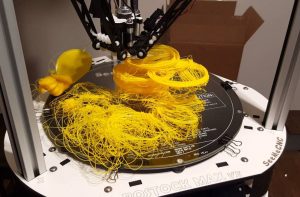
Retraction Rate- Since the filament in the extruder is under constant estrus, it volition always want to menstruation out of the extruder. As the nozzle moves about, small $.25 of filament may be extruded unintentionally. The retraction setting allows the filament to be withdrawn dorsum to prevent this from happening. Too little a retraction rate volition cause strings, while too great may actually air current the filament out of the extruder. Once over again, a setting that may some testing to detect what works best, it besides depends on the filament used as well as the temperature.
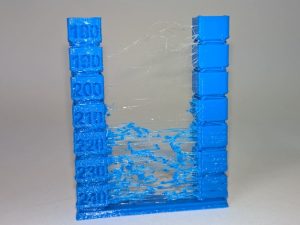
There are more settings than those listed, simply these are ordinarily the ones that impact print quality the most. Some other factor that tin affect prints is random bugs in software or issues in the actual model that affect slicing. This is why yous should always review your model after information technology has been sliced in your slicer software before uploading information technology to the printer. Some slicers accept their ain file repair settings, only online repair services can be good besides. https://makeprintable.com https://tools3d.azurewebsites.internet
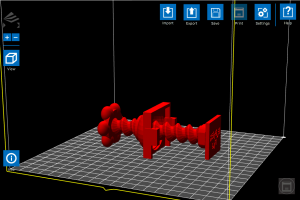
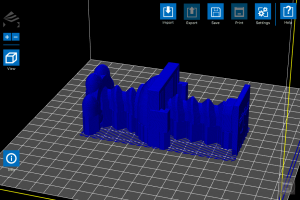
3. Hardware
3D printers, similar all machines, can and volition eventually fail and usually require maintenance. Yous don't necessarily accept to take your printer autonomously bit by bit, but yous definitely demand to check on your printer and its components every now and and so to ensure every things is fully functional. If desired, you can also upgrade your printer parts with purchasable upgrades, or fifty-fifty print add together-ons that will improve print quality.
Extruder- The integral part of the printer responsible for the actual printing. A user needs to make certain that this piece is fully functional and taken care of, otherwise no printing can occur. Taking care of your extruder is relatively simple. Simply make certain that it is not overworked and kept clean. Prints that run for hours are fine, but you definitely y'all should not have your printer running 24/vii. After a long impress mayhap give it a break for a few hours or so. Make sure to practice proper fan usage. It is wise to take at least one, if non fifty-fifty 2 fans running on the extruder during prints. This improves print quality and extends the lifetime of the component. Also, whenever possible brand sure to allow your fan to cool off your extruder instead of just turning the printer off. By allowing the fans to run after a print, the extruder can absurd properly and gradually unit of measurement the adjacent print. Overheating tin cause filament to stop flowing entirely and damage the extruder, so be wary of this. Information technology is also a skilful thought to perchance open upwards your extruder whenever you see an issue in printing or just feel like information technology's time to clean it. When attempting cleaning, a wire brush is usually the get-to tool every bit virtually if not all extruder nozzles are made of metals like brass.
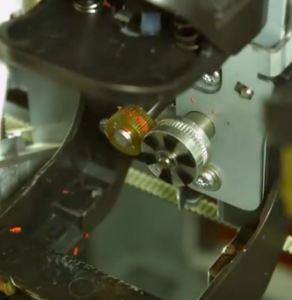
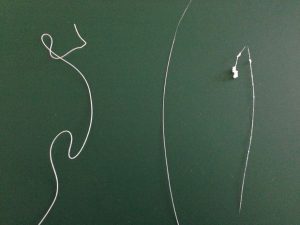
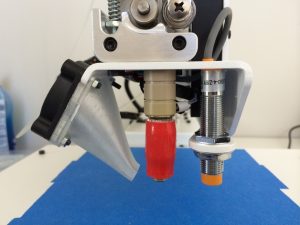
Build plate- Maintaining the integrity of the build platform is primal to ensuring skillful prints. While they can be fixed/replaced like extruders, they are usually much more hard to practise then. Ane of the most important aspects to wait out for is leveling, as in keeping a proper distance between the extruder nozzle and the build surface. Too far and the filament will non stick; besides close and the filament volition accept no room to leave the nozzle and the bed may be damaged. Most printers come with instructions on how to properly level the bed, and some even have motorcar-leveling settings. Transmission offsets can too be input if desired. Like the extruder, it is of import to keep the bed clean, as residue from prints and glue for adhesion if used, tin can buildup overtime and harm the surface as well equally your prints. One method of preventing this is using painter'due south tape. Past applying it over the build plate, you lot tin can provide a surface that in some cases is actually ameliorate for adhesion than the actual platform, equally well as easily peel off the prints afterwards. It also assists in protecting the bed. Many printers also come with beds made from drinking glass, which must be taken care of with circumspection, as overheating or mishandling of the printer can damage the bed severely and go a prophylactic hazard.
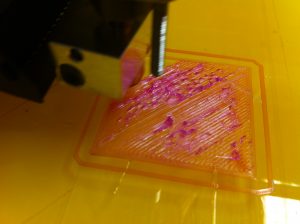
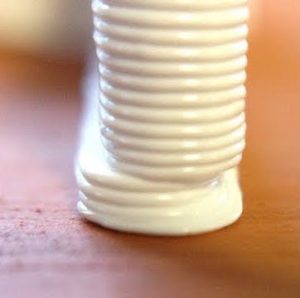
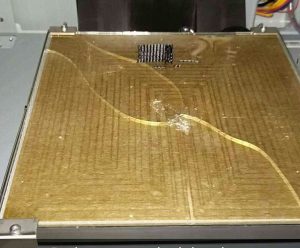
Motors- In society to drive the axes of the printer's nozzle and bed, stepper motors are used. I motor is used for each axis(X, Y, and Z), and the extruder and bed can either share all three, or one may posses all of them (in which case that corresponding part would be the only one moving). These motors are what allow 3D printing to be 3D. Virtually use tension belts or rods to move the extruder and/or bed. This motors don't require every bit much maintenance and checking as the nozzle or bed, but it is certainly a skillful thought to cheque on them and perhaps regrease them every at present and then. Y'all may also want to check the wiring on the motors, as the repeated motion of moving back and forth can actually break them and sometimes even get caught in the gears, finer ruining the printer. Unless you're experienced in electronics, this can be difficult to fix. Taking adept care of your motors can non only salvage you lot from ownership new ones later, but as well ameliorate print quality. Everyone tin can agree that the smoother a print is, the meliorate it looks and the college quality it is. The accuracy of the prints depend on the stability of the motors. If they are too tight or too loose, your prints will suffer.
A stepper motor with a loosened belt
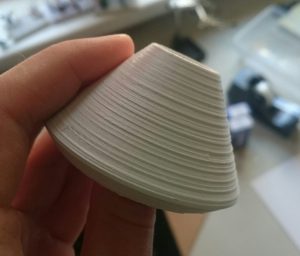
For this calendar week, we delved into the last stretch of the course: our Concluding Project. Each group some sort of solution to a trouble of their choosing; big or small-scale. The issue or solution does not necessarily take to be 3D printing-related, but simply portray the aspects of design and making that we have learned over the class of the semester. Although, most of the last projects do include 3D printed models to some degree. This week, nosotros began the first stage(s) of our projects.
My team and I, the MakerLAX, decided aimed to resolve an result that was felt by many college students and other young adults: tying ties. Equally one gets older, they will have to attend more and more formal events and gatherings, and as such will crave more than formal dress. The tie is an integral part of formal attire, but is notoriously difficult to ready for the get-go time, as well as long afterward. It may seem like relatively uncomplicated task, merely getting accustomed to tying a necktie too as all the different knots that in one case can choose from takes time. This combined with the fact that most young adults only really take to clothing ties from time-to-fourth dimension and not on a daily basis, makes learning the ins and outs of tying one somewhat difficult. I personally require assistance from someone who already has gone through the whole process of learning how to tie a tie, or watching an online tutorial whenever I find myself needing a tie. While this may not exist an inherently large problem, it tin can certainly be helped.
The premise behind our solution is to create a sort of "necktie-helper", equally in, an object about the size of a small paperweight that can act as a guide for a person to use to tie their tie. Nosotros have found remnants of what appear to be previous attempts at creating such a product, just they were either flawed or never actually reached production. https://www.youtube.com/picket?v=D3tkWcp3wK4 Our group is aiming to create a design that tin be mass-produced or fifty-fifty printed at domicile. The idea equally it stands so far is to print a model that is inscribed with numbers and/or pictures of instructions on how to tie a specific knot that has even so to be chosen. After finishing the knot, the object can be hands separated from the tie and the necktie will already exist tied around the cervix. In class, nosotros presented our idea to the rest of the groups and were given feedback. Nosotros also created some crude models of possible designs, which could exist considered our initial prototypes. From here, we will be creating and testing new models to perfect for our terminal iteration. We've all learned a lot these past few months in Digital Making; I am really looking forward to putting information technology to good utilise, too as seeing what anybody else comes up with.
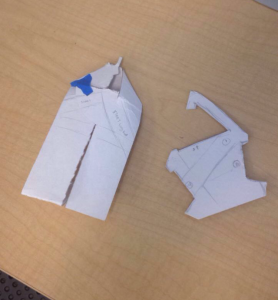
This calendar week'due south session marked our final week at the Fab Lab. Our time spent hither was memorable and it's pitiful to say that this is our concluding class time here, but the skills and know-how gathered hither were quite memorable and are sure to concluding us quite a while. To conclude our iii calendar week journey, everyone participated in their terminal workshop to finish our lite boxes. For me, it was finally time to code.
Having finished all the hardware aspects of the project, the last remaining task was the virtually integral to the box's function: its programming. The Arduino itself is a powerful tool, simply it cannot exist used to its full potential without working with coding. The capabilities of a programmed Arduino are only limited past its user. Existence an electrical applied science major, I'm required to have expertise in programming. Most of the programming that I currently practise is in C programming, which is what the Arduino IDE (Integrated Development Surroundings) is based off of. I don't actually bargain with the actual custom Arduino software much, nonetheless, and so information technology was good to get some practice with this.
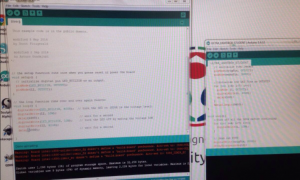
Nosotros began with the basics, making a simple LED blink. And then nosotros gradually moved on through the Arduino language to where we would be able to blueprint a program that would make the lite box behave equally we wanted it to: equally a light sensor with LEDs that activate accordingly to the level of light. The Arduino IDE is custom built for the various modules that Arduino produces, and every bit such their certain commands and implications available only to information technology and not in conventional C programming. We began creating slightly more than complex circuits on a test breadboard preparation for the last step of the project. We were allowed to play around and "hack" the programs provided to us so we could get a better feel of the software. This also allowed us to customize each of our light boxes to our preferences. We could select which LEDs would calorie-free upwards and in what guild, the amount of light exposed to the sensor which would cause it to ship signals to the LED, and so on. Relatively small-scale adjustments, but those fiddling differences were what immune us to differentiate our final projects from each other. We finished compiling our lawmaking and assembled our boxes that we got to accept dwelling house as a trophy for our weeks of piece of work.
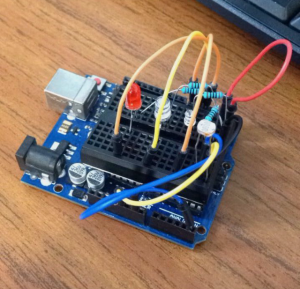
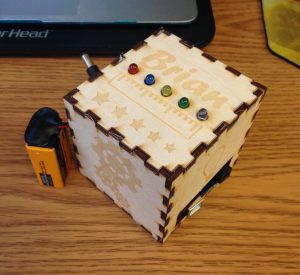
It may have taken identify over a few weeks, but our time spent at the Fab Lab seemed relatively short. I cherish the skills I've gained here and the memories of the fun I've had these past few weeks volition last my lifetime every bit a maker(i.east. the rest of my life). We've come up quite a way from our commencement session here, and our terminal form projects also as our abilities as makers have certainly benefited from it all. The Fab Lab was such an amazing feel: I loved being surrounded not only past all the astonishing technological tools and processes, but by other inspired and talented people likewise.
For our 2d visit to the Fab Lab, each grouping switched stations to work on a dissimilar portion of our last project. This calendar week, I attended the Light amplification by stimulated emission of radiation Cutting session. Though the workshop is somewhat secluded towards the back of the Fab Lab, it certainly shines through as i of the more unique creative processes the Fab Lab has to offering (no pun intended).
In my last workshop, nosotros focused on designing the physical circuit for our calorie-free-sensitive boxes. This calendar week, nosotros continued with moe hands-on work dedicated to making the advent of the project aesthetic and to our liking. By using specifically designed software, we were able to create layouts for our boxes that we could customize. Nosotros first gained the template after entering our desired dimensions into an online resource, and so imported that file onto the lab calculator software Inkscape to customize them. We were able to select images online to utilize as stencils for the panels. The images had to be completely blackness & white, as well every bit properly pixelated. The laser cutters are incredibly precise, and are able to stencil out wood portions with cuts of down to .001 m in width, resulting in flawlessly plumbing fixtures pieces and stellar quality of silhouettes. Ane of the most amazing bits of all this, is that each person's cuts only took approximately 20 minutes maximum, style faster than a conventional 3D printer. While it is certainly a sight to see something create out of nothing, some don't realize that you tin can also reach great designs by taking away from what you already have.
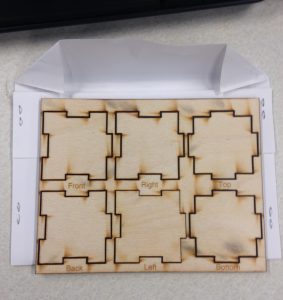
For my custom designs, I chose each side to represent a field of engineering/design as I am an technology major. Four sides included images reminiscent of electrical, mechanical, and computer engineering, too as architecture. The underside of the box features a 3D printer silhouette as well as that of a laser cutter, the two main methods of blueprint that my group will probably use in our concluding project. The remaining side but has my proper noun with a special measurement organization equanimous of a ruler epitome and different sized stars to correspond the brightness of the LEDs.

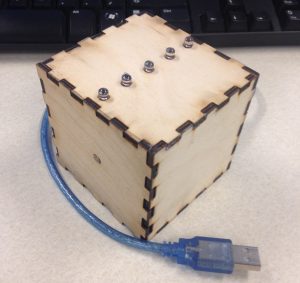
Now that I've completed both the physical portions of the workshop, I'm excited to take part in the coding session next week, where we will program the Arduino with the desired code to allow it to respond every bit we desire it to. I've thoroughly enjoyed these Fab Lab sessions not only because nosotros go to create a custom projection for ourselves to keep in the end, simply nosotros besides get to encounter multiple types of engineering and designing intertwined (specifically electronics, mechanics, and programming) into a single project. It's been a fantastic experience to work with all these unlike processes, and I'thousand hoping that we can incorporate every one of them into our final project.
This week, nosotros paid a visit to the surprisingly out-in-the-open up Champaign-Urbana Customs Fab Lab; a free community center-like makerspace open up for anyone. The Fab Lab is aptly named as the inner workings of the building are almost like a laboratory filled with fabulous creations by the volunteers and others who happen to stop by. Unlike our Digital Making Lab, information technology contains not only 3D printers, merely other varieties of technology designed for the specific purpose of creation. These include sewing machines, paper cutters, light amplification by stimulated emission of radiation engravers, and soldering stations. The lab contains a plethora of methods for people to express their creativity; it's a shame that it is not very well known.
For the first week here in our iii part saga in this lab, i person from each of our groups was assigned to a station in the lab where nosotros would participate in a different workshop to make something out of cipher. For my personal station, nosotros worked in electronics. I chose this because equally an electric engineering major it was definitely in my all you expertise and I knew that I would be able to acquire something to meliorate upon. Our projection was creating a blazon of light-sensing electronic circuit using LEDs, a photocell resistor, and an Arduino. Depending on the amount of light sensed by the resistor, a unlike color LED would light up. If no light was sensed, and so all the LEDs would turn on. The project involved looking at some schematics and quite a flake of soldering, and the end result as it currently stands (an Arduino board with a agglomeration of wires and LEDs branching everywhere) did non look so highly-seasoned, simply the functionality was the true beauty of it. Plus, we should exist able to meliorate upon and make the design "prettier" in our next workshop. The other two groups were separate into those working with laser cutters and coding in the computer lab portion of the Fab Lab. Laser cutting is another type of 3D printing in a sense, merely in a mode opposite to the norm. Instead of starting with nothing, your starting material is already there. You only need to decide upon a design and what portions yous wish to cutting out rather than add on. The results are stunningly precise. And while coding might not seem every bit glamorous equally the other ii activities, it is the footing of modern day electronics. Almost every device for use by citizens requires some programming: phones, computers, televisions, and the 3D printers nosotros use in our lab. It may non inherently brand some visually stunning object, merely without information technology nosotros wouldn't be able to use the machines that make those objects in the first place. All in all, these activities were extremely enjoyable to spectate and participate in, and in doing so we've gained knowledge of more than methods for our apply in non but our final project, just Making as a whole.

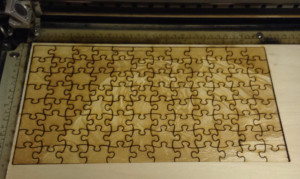
This week, we met in our MakerLab for the showtime time in a piffling while. But nosotros weren't at that place to print anything just yet, at least non for the class. This session, we began the process of creating ideas for our course projection. This isn't always as easy equally it sounds, yet, equally the first steps of design thinking can really be the well-nigh hard.
A major difficulty of problem-solving is deciding what problem to solve. If i already has an idea in heed, this can be easier, but for someone who simply has a wide telescopic of issues, it tin can be hard to narrow it down. Fifty-fifty with the 3 of usa in my group, it took u.s. quite sometime to find a trouble that we idea would be worth fixing. Not all "problems" take solutions; some tin just exist improved. But just because they can, doesn't mean they have to. It is perfectly fine to make modest adjustments to existing designs or solutions, but we decided to create a whole other arroyo entirely for "more serious matters". Being college students, nosotros focused on issues that most immature adults seem to have. We concluded uncreating 3 relatively straightforward designs: a tie helper, pocket stopper, and earbud holder that could as well be used as a speaker.
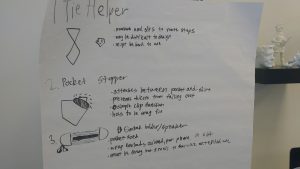
An of import aspect in improving and finalizing a solution is getting feedback from others. Communicating one's ideas to others allows them to go some other perspective and preclude creator bias, information technology as well is an opportunity to maybe receive criticism and suggestions for improvements. Something to exist wary of in creating solutions is beingness to close-minded or focused on your own opinions of the effect rather than those of people who desire a solution to said problem. Even if the creator of such a solution is plagued by the same event, people take unlike levels of impact from it. Equally Duncan Brennan'due south weblog "The Fine art of Engineering science" states "[creating solutions] requires more lateral thinking and gathering information from a far wider variety of sources". Problem-solvers sometimes go so absorbed in trying to discover/create a ready that they forget the very purpose for doing so: to assistance others. We work to resolve these issues considering they have personal pregnant, or because we simply wish to make the world a better place for all.
Being a trouble-solver can exist an extraordinarily beneficial experience. Ane can grasp and gain the tools to assist those in demand with solutions: no matter how elementary or complex they may exist. One tin discover more than most themselves; how they wish to do good the world, what skills they possess or would like to improve. According to the Harvard Gazette, "One of the nearly exhilarating aspects of [an engineering/design curriculum]… is the opportunity to make stuff". That "stuff" is both their solutions to problems and the benefits to the world that come of it.
In the prior calendar week, we we participated in a workshop that outlined the basics of the design process. This calendar week, nosotros given a visit past Jeff Smith, an industrial designer working for Autodesk, who explained the basics of Fusion 360 and demonstrated the capabilities of the software. Jeff was trained in the "analog" method of blueprint, in which all the blueprints and 2d models of a products were handmade with paper and pencil, a stunning but arduous process. In this digital age, 1 can do the same and more with CAD software like Fusion 360.
The base of operations of CAD software is relatively straight forward: past using computerized tools, i can create a model of their choosing in real-time without the crutches of bodily drawing such as drawing utensils or having to offset from scratch every time. Jeff demonstrated that Fusion 360 tin be utilized to create models in a variety of formats using a multifariousness of methods. These range from organic to inorganic shapes, sketches, revolutions, scaling, etc. Fusion 360 possesses an extensive amount of tools and edits at the user's disposal, giving the user a plethora of options. This also, however, makes using the software quite difficult, especially if i has never used CAD before. Fusion 360 is a intermediate-to-expert level software, different TinkerCAD (https://www.tinkercad.com ), which is a beginner software. The interface is rather unconventional, and there are many "subconscious" tools throughout Fusion that go far uncomfortable for even experienced CAD users. Even with the plethora of tutorials out in that location (https://www.youtube.com/playlist?list=PLTuzDPYYeEeJ9E-xBX2n-dUo6p8fQeA_b&jct=Ae3fFWiQBw0JsXyUzPflRHCUzfNjKQ), adjusting to Fusion can exist cumbersome. Yet, in one case one gets used to these quirks, the software can be more than easily used to its full potential.
In Jeff'due south workshop, he portrayed how many of the characteristics of 3D modeling, while used in a dissimilar manner, were very similar to real life drawing and design. You tin use a pencil-like tool to sketch shapes, if you fabricated mistakes you didn't necessarily accept to starting time all over, but would accept to practice something like to erasing. It really depends on the person on whether designing on paper or in CAD is more difficult. The main cadre similarity of the two is that they are both an fine art class. One can translate their creativity and design thinking onto a platform that allows them to portray it to others. The reason why CAD such as Fusion 360 is arguably better is that others tin both observe AND edit your designs easily, all of which is saved through the cloud. This makes prototyping and customizations significantly easier, all through a single abstract. Information technology allowed me to blueprint a mockup of a mechanical pencil and information technology'south components. I can likewise utilize this to explicate to someone how it functions without actually needing a physical one. CAD is wonderful tool for both expression and cosmos. Many believe it to exist exclusively for engineering purposes, which maybe true, but in reality it is for portraying your technical expertise and creative procedure.
Privacy
© 2022 University of Illinois Lath of Trustees
Source: https://publish.illinois.edu/digitalmaking2017/author/brianxu2illinois-edu/

0 Response to "Special Thanks to Caseys42/jjj for Making the Picture and Allowing Me to Upload It~"
Post a Comment